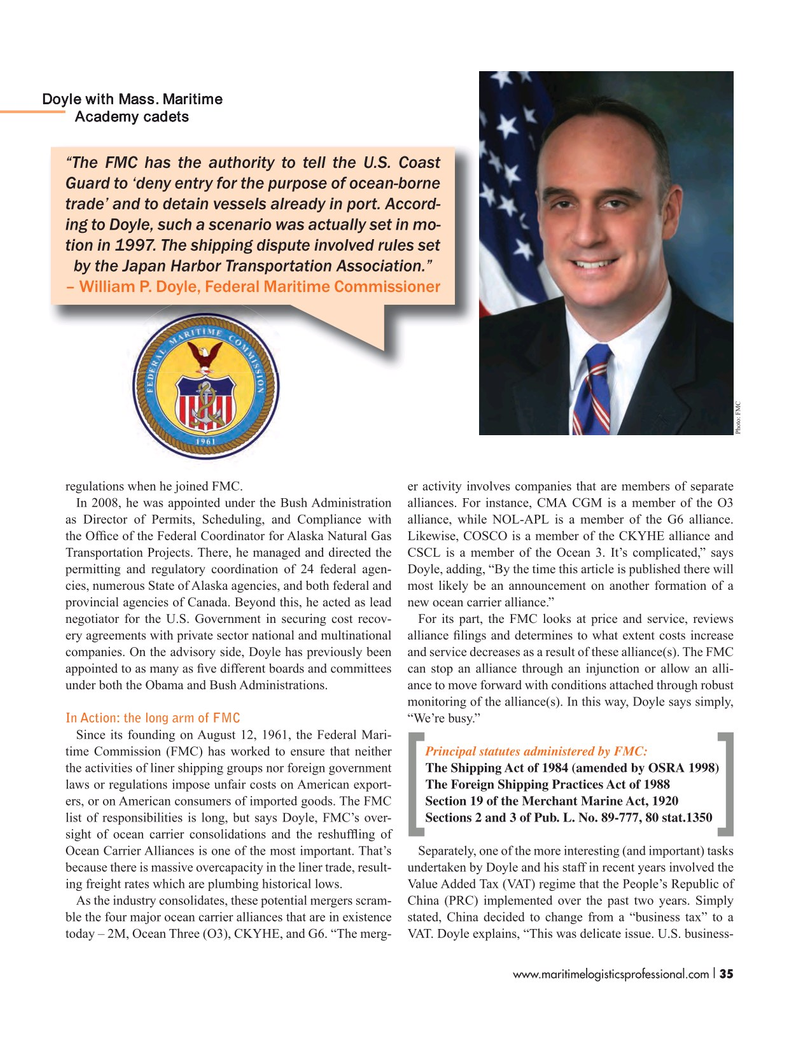
Page 35: of Maritime Logistics Professional Magazine (Q3 2016)
Shipbuilding, Repair & Maintenance
Read this page in Pdf, Flash or Html5 edition of Q3 2016 Maritime Logistics Professional Magazine
Doyle with Mass. Maritime
Academy cadets “The FMC has the authority to tell the U.S. Coast
Guard to ‘deny entry for the purpose of ocean-borne trade’ and to detain vessels already in port. Accord- ing to Doyle, such a scenario was actually set in mo- tion in 1997. The shipping dispute involved rules set by the Japan Harbor Transportation Association.” – William P. Doyle, Federal Maritime Commissioner
Photo: FMC regulations when he joined FMC. er activity involves companies that are members of separate
In 2008, he was appointed under the Bush Administration alliances. For instance, CMA CGM is a member of the O3 as Director of Permits, Scheduling, and Compliance with alliance, while NOL-APL is a member of the G6 alliance. the Of? ce of the Federal Coordinator for Alaska Natural Gas Likewise, COSCO is a member of the CKYHE alliance and
Transportation Projects. There, he managed and directed the CSCL is a member of the Ocean 3. It’s complicated,” says permitting and regulatory coordination of 24 federal agen- Doyle, adding, “By the time this article is published there will cies, numerous State of Alaska agencies, and both federal and most likely be an announcement on another formation of a provincial agencies of Canada. Beyond this, he acted as lead new ocean carrier alliance.” negotiator for the U.S. Government in securing cost recov- For its part, the FMC looks at price and service, reviews ery agreements with private sector national and multinational alliance ? lings and determines to what extent costs increase companies. On the advisory side, Doyle has previously been and service decreases as a result of these alliance(s). The FMC appointed to as many as ? ve different boards and committees can stop an alliance through an injunction or allow an alli- under both the Obama and Bush Administrations. ance to move forward with conditions attached through robust monitoring of the alliance(s). In this way, Doyle says simply,
In Action: the long arm of FMC “We’re busy.”
Since its founding on August 12, 1961, the Federal Mari- time Commission (FMC) has worked to ensure that neither Principal statutes administered by FMC: the activities of liner shipping groups nor foreign government The Shipping Act of 1984 (amended by OSRA 1998) laws or regulations impose unfair costs on American export- The Foreign Shipping Practices Act of 1988 ers, or on American consumers of imported goods. The FMC Section 19 of the Merchant Marine Act, 1920 list of responsibilities is long, but says Doyle, FMC’s over- Sections 2 and 3 of Pub. L. No. 89-777, 80 stat.1350 sight of ocean carrier consolidations and the reshuf? ing of
Ocean Carrier Alliances is one of the most important. That’s Separately, one of the more interesting (and important) tasks because there is massive overcapacity in the liner trade, result- undertaken by Doyle and his staff in recent years involved the ing freight rates which are plumbing historical lows. Value Added Tax (VAT) regime that the People’s Republic of
As the industry consolidates, these potential mergers scram- China (PRC) implemented over the past two years. Simply ble the four major ocean carrier alliances that are in existence stated, China decided to change from a “business tax” to a today – 2M, Ocean Three (O3), CKYHE, and G6. “The merg- VAT. Doyle explains, “This was delicate issue. U.S. business- www.maritimelogisticsprofessional.com 35
I 34-49 Q3 MP2016.indd 35 8/17/2016 10:31:28 AM

 34
34

 36
36
